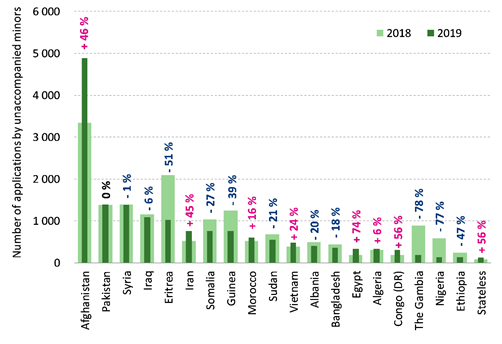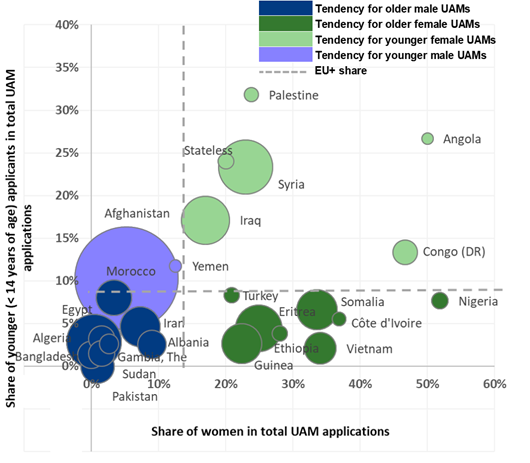
According to the Eurostat Technical Guide, applications for international protection lodged by unaccompanied minors are counted as such when the age of the applicant has been accepted by the national authority. When an age assessment is carried out by the Member State, the age reported shall be the age determined by the age assessment procedure.
In 2019, about 17 700 applications for international protection were lodged by unaccompanied minors, representing 2 % of the total 740 000 applications overall. While total applications increased in EU+ countries, the share of unaccompanied minors decreased compared to the share in 2018 (3 %).
In absolute numbers, there was a 13 % decrease in the number of applications by unaccompanied minors between 2019 and 2018. But the regional total can mask great variations at the country level.
Countries receiving applications
More than one-half of all applications by unaccompanied minors were registered in just three EU+ countries, namely the United Kingdom (21 % of the total), Greece (19 %) and Germany (15 %).
In addition, many EU+ countries (with more than 500 applications by unaccompanied minors) received higher numbers than previously. For example, Austria received more than double, with 121 % more applications from minors in 2019 than in 2018. This was followed by Belgium (+ 63 %), Greece (+ 26 %), Slovenia (+ 21 %) and the United Kingdom (+ 19 %).
In contrast, Germany received far fewer applications from minors, with 34 % less than in 2018. The most dramatic development took place in Italy, where applications from unaccompanied minors dropped by 83 %, from almost 3 900 in 2018 to less than 700 applications in 2019.
Nationality of unaccompanied minor applicants
While the origin of all applicants, including unaccompanied minors, can fluctuate from year to year, in 2019 there was a sharp increase in unaccompanied children from Afghanistan, with a 46 % rise compared to 2018 (see Figure 6.1).
Figure 6.1 Number of applications for international protection lodged by unaccompanied minors, by citizenship, 2018 and 2019
Source: Eurostat.
Countries receiving applications from unaccompanied minors
One-quarter of all unaccompanied Afghan minors lodged applications in Greece. Their number of applications also increased in Belgium (where they more than doubled to 650 applications), Austria (almost four times higher at 640 applications) and the United Kingdom (almost doubling with 425 applications). In contract, Afghan minors applied less often in Germany than in previous years, with a 32 % drop.
Greece also attracted the vast majority of applications from unaccompanied minors from Egypt (78 %) and most from the Democratic Republic of the Congo (44 %).The United Kingdom was the destination for 92 % of minor applicants from Vietnam and 69 % of those from Iran, (an increase compared to 2018).
A significant trend in 2019 was a sharp drop in the number of unaccompanied minors from sub-Saharan Africa compared to 2018. This accounted for the decline in applications lodged by minors in Italy due in part to a drop in irregular entries via the Central Mediterranean route and a cessation of search and rescue operations. As such, far fewer unaccompanied minors from Eritrea applied for international protection overall in EU+ countries, and particularly in Germany (- 77 %), the Netherlands (- 74 %) and Italy (- 64 %).
Italy also had the largest decrease of applications by minors from Gambian (15 applications in 2019 compared to 645 in 2018), Guinea (15 in 2019 compared to 385 in 2018) and Nigeria (30 in 2019 compared to 415 in 2018). Applications from unaccompanied minors from these countries of origin remained stable in the rest of EU+ countries in 2019 when compared with figures from 2018.
Although in absolute numbers most unaccompanied minors were from Afghanistan, in relative terms Vietnam had the highest share of minors, representing 14 % of the total applications lodged by nationals of this country (see Figure 6.2).
As seen in previous years, higher shares of unaccompanied minors were more common among applicants from sub-Saharan African countries, while their absolute numbers decreased to different degrees in 2019. In particular, minor applicants from The Gambia dropped from accounting for 17 % of all applications by Gambians in 2018 to just 4 % in 2019.
Figure 6.2 Share of applications for international protection lodged by unaccompanied minors, by country of origin, 2019
Source: Eurostat.
Characteristics of unaccompanied minor applicants
As seen in previous years, the overwhelming majority of unaccompanied minors applying for international protection in EU+ countries were male (86 %) between the ages of 14 and 18 (91 %). This was particularly the case for nationals of most north African countries (for example, Algeria, Egypt and Morocco) and Asian countries (Afghanistan, Bangladesh and Iran) (represented in dark blue in Figure 6.3).
A few sub-Saharan African countries had relatively high shares of female minor applicants as well. In fact, there were more girls from Nigeria than boys (52 %) seeking asylum in EU+ countries in 2019. The female applicants, however, tended to be of an older age cohort, generally older than 14 years.
Applicants younger than 14 years of age are considered to be a particularly vulnerable group. As seen in Figure 6.3, Palestine had the highest share of applicants younger than 14 years, at 33 %. This was followed by Angola (27 %) and stateless persons (24 %). The countries plotted in light green in the top-right quadrant of the figure had higher shares of young female applicants than the average for EU+ countries, at 9 %. Among applicants seeking asylum in Europe from Angola and the Democratic Republic of the Congo, nearly one-half were girls.
Figure 6.3 Share of applications for international protection lodged by unaccompanied minors, by sex and age group, 2019
Note: The size of the bubble indicates the total number of unaccompanied minors.
Source: Eurostat.
Previous |
............... |
Home |
................... |
|
Next |


